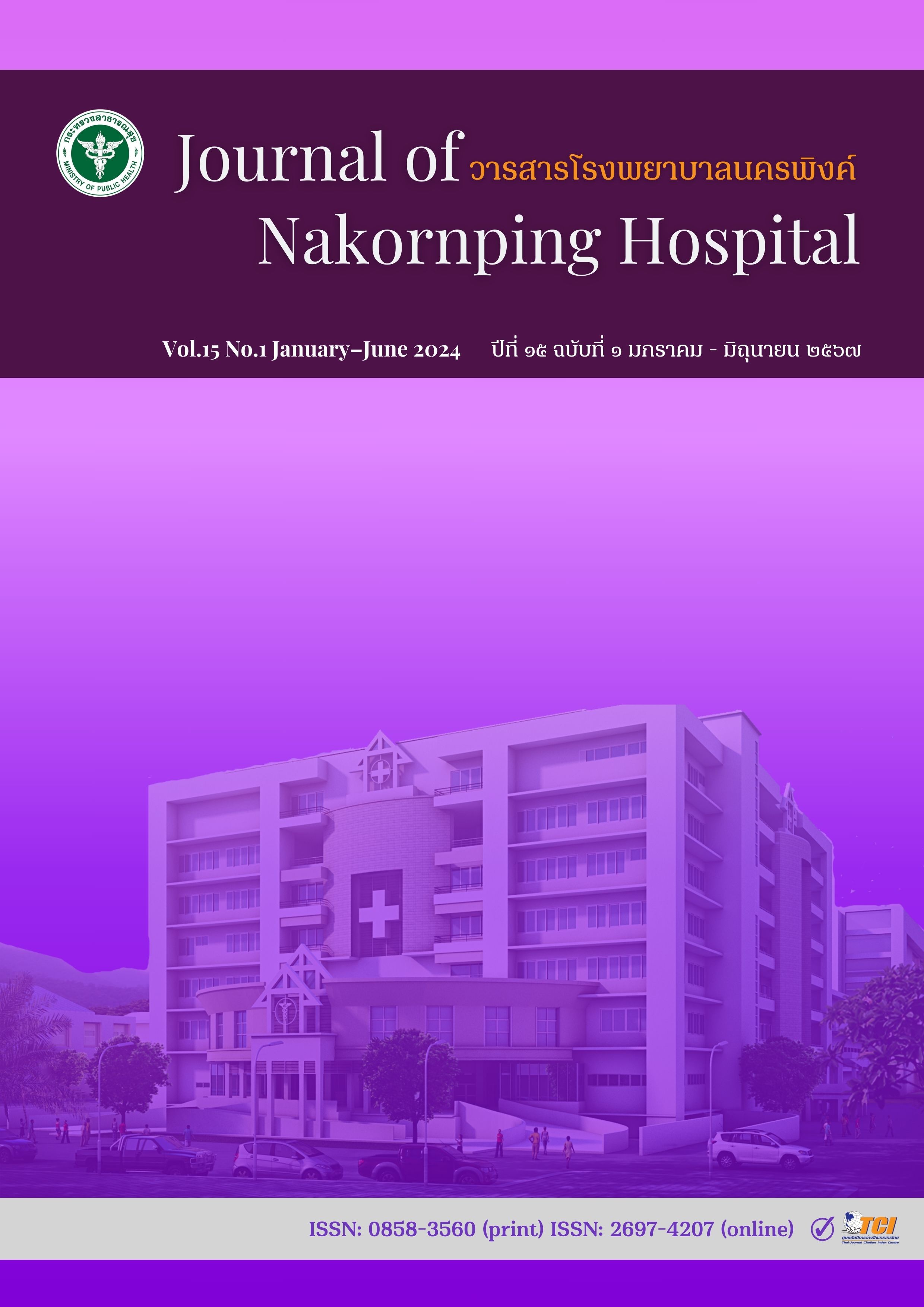Comparison of health care outcomes between self-modification of health behavior and health behavior modification programs designed for risk group staff of metabolic syndrome
Keywords:
comparison, health behavior, risk group of metabolic syndromesAbstract
The purpose of this quasi-experimental was to study healthcare outcomes before and after participating in the program, as well as to compare healthcare outcomes during a health behavior modification program designed for metabolic syndrome risk groups. The sample group consisted of staff at risk of metabolic syndrome recruited from the annual health check-up results of Srisangwan Hospital. Thirty-four participants were selected using purposive sampling and divided into two groups: an experimental group of 18 staff and a control group of 16 staff. The research tool was a questionnaire consisting of two parts: general information and health information. Data were collected between July and December 2020 and analyzed using descriptive statistics such as percentages, averages, and inferential statistics, including paired t-tests and independent t-tests.
Results: The study showed that 88.90% of the experimental group were female, with an average age of 48.11 ± 6.4 years. The average body weight, BMI, waist circumference, and HDL before participating in the program were 69.34 ± 7.31 kg, 27.62 ± 2.61 kg/m2, 90.25 ± 7.22 cm, and 45.61 ± 10.86 mg/dl, respectively. After participating in the program, these values changed to 67.26 ± 7.10 kg, 26.73 ± 2.58 kg/m2, 87.36 ± 7.13 cm, and 49.16 ± 9.26 mg/dl, respectively. Statistical analysis revealed significant differences in average weight. However, there was no statistical difference in BMI, waist circumference, HDL levels, blood pressure, FBS, and triglyceride levels. The control group had an average waist circumference of 89.50 ± 7.20 cm before entering the health promotion program and 87.43 ± 7.35 cm after the program. There was no statistical difference in BMI, waist circumference, blood pressure, FBS, triglyceride, and HDL levels. There was no statistical difference between the experimental group and the control group when comparing weight, BMI, waist circumference, blood pressure, FBS, triglyceride, and HDL levels before and after participating in the program.
Conclusion: The study suggests that hospital staff already have knowledge of primary healthcare, indicating the importance of encouraging continuous and sustainable self-care and health modification. This can be achieved through the formulation of corporate health policies, building collaboration within departments, adjusting activities to suit target groups, and encouraging personnel to change health behaviors.
References
Wattanawittawat P. Obesity [Internet]. chiangmai: Sriphat Medical Center; c2018 [update 2018 Mar 22; cited 2020 Jan 26]. Available from: https://sriphat.med.cmu.ac.th/en/knowledge-509 [In Thai]
Prasittipatt T, Rudtanasudjatum K, Methaphat C, Thetkathuek A. Factors Influencing the Abdominal Obesity of Employees in Large-sized Manufactories in the Eastern Region. Journal of health science. 2018;27(5):792-9. [In Thai]
Department of Health Annual Report 2017 [Internat]. bangkok: Graphic and Design Publishing; c2018 [update 2020 Dec 9; cited 2020 Jan 14]. Available from: https://backenddc.anamai.moph.go.th/coverpage/c68879242af9af26144520f4caee6930.pdf [In Thai]
Maehongson Provincial Public Health Office. Health Data Center of Maehongson Province 2020 [Internet]. Maehongson: Maehongson Provincial Public Health Office; c2020. [cited 2020 Jan 14]. Available from: https://msn.hdc.moph.go.th/hdc/main/index.php [In Thai]
Srisangwan Hospital. Annual Health Check-up Report 2020. Maehongson: Srisangwan Hospital; 2020. [In Thai]
Trumikaborworn S. Pender’s Health Promotion Theory [Internet]. c2012 [update 2012 Aug 29; cited 2019 Dec 13]. Available from: http://www.nurse.ubu.ac.th/sub/knowledgedetail/PD.pdf [In Thai]
Intarakamhang U, Malarat A. The Effect of Health Behavior Modification based on Client Center Program to Self – Care Behavior of Obese Students [report]. Bangkok: Srinakharinwirot University; 2012. Available from: http://bsris.swu.ac.th/upload/141.pdf [In Thai]
Palapol T, Suwonaroop N, Ruangjiratain S. The Effect of Enhancing Perceived Self-efficacyProgram on Food Consumption and Exercise Behaviorin Adults at Risk for Metabolic Syndrome. Journal of Nursing Science Chulalongkorn University. 2017;29(1):81-91. [In Thai]
Phunsilp B, Pansila W, Boonsankorm R. Development of Operations Management to Reduce For Obeses People in Community Nong Sang Sub-District, Wapi Prathum District, Mahasarakham Province. Journal of Science & Technology, Ubon Ratchathani University. 2017;19(2):108-23. [In Thai]
Boontein P, Saneha C. Factors Predicting Metabolic Self-Management Behavior among Patients with Metabolic Syndrome at One University Hospital in Bangkok. Journal of Nursing Science. 2017;35(3):70-81. [In Thai]
Downloads
Published
How to Cite
Issue
Section
License
Copyright (c) 2024 Nakornping Hospital

This work is licensed under a Creative Commons Attribution-NonCommercial-NoDerivatives 4.0 International License.
The articles that had been published in the journal is copyright of Journal of Nakornping hospital, Chiang Mai.
Contents and comments in the articles in Journal of Nakornping hospital are at owner’s responsibilities that editor team may not totally agree with.



